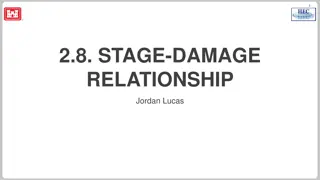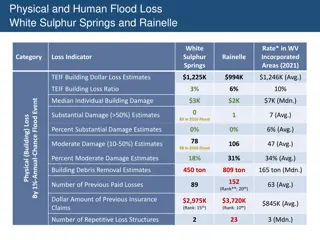Materials Damage Session Overview
The Materials Damage Session led by Catherine Romano covers various topics such as issues for non-light water reactors, fusion systems, and radiation damage cross sections. The session aims to understand data gaps, identify solutions across DOE programs, and leverage international efforts to make actionable conclusions. Participants are tasked with removing institutional bias, creating a multi-program plan, and addressing material lifetime prediction challenges within limited budgets.
Uploaded on Sep 17, 2024 | 0 Views
Download Presentation

Please find below an Image/Link to download the presentation.
The content on the website is provided AS IS for your information and personal use only. It may not be sold, licensed, or shared on other websites without obtaining consent from the author. Download presentation by click this link. If you encounter any issues during the download, it is possible that the publisher has removed the file from their server.
E N D
Presentation Transcript
WANDA Materials Damage Cross Section Breakout Session Session Lead: Catherine Romano
Materials Damage Session Agenda Wednesday, Jan 23rd 1315-1700 State Room Time Talk 1315 Introduction and guidelines 1325 Materials Issues for Non-light Water Reactors 1335 Materials Issues for Fusion systems 1345 IAEA work on primary radiation damage cross sections The Impact of ENDF/B-VIII.0 and FENDL-3.1d on Fusion Neutronics Calculations 1415 Fusion Nuclear Science Facility Speaker Catherine Romano ORNL Raj Iyengar Daniel Clark Arjan Koning NRC Office of Science, Fusion IAEA 1400 Tim Bohm Chuck Kessel Univ. Wisc.-Madison ORNL 1430IAEA CRP on Primary Radiation Damage and SPECTERLarry Greenwood PNNL 1445 Damage correlation: Exposure vs material damage 1455 BREAK 1515 Materials damage characterization Neutron Dosimetry with STAYSL for Materials Irradiations and the IAEA CRP on IRDFF Activation and Damage Cross Sections in Use for EUROFusion Fusion Nuclear Technology Roger Stoller ORNL retired Peter Hosemann UC Berkely 1530 Larry Greenwood PNNL 1545 Bob Grove ORNL Using heavy ion beams to study radiation damage in fuel elements and structural materials for reactors 1600 1615 Discussion 1700 END Jerry Nolan Catherine Romano ORNL ANL
Session Goals Understand the state of the sigma-dpa/gas production data Identify the gaps Determine potential solutions that incorporate all capabilities across the DOE complex Identify cross cutting solutions (what other programs may be impacted?) Identify areas where other work can be leveraged i.e. international efforts Provide actionable conclusions
Charge to session participants Participate in discussion Remove institutional bias! Create a national, multi-program plan
Charge to Session Lead Facilitate the conversation to result in actionable information Table conversations best addressed outside of the session Assume I am a new program manager with no previous information and a background in general nuclear physics (easy role for me!) How do I solve my materials lifetime prediction problems within limited budget?
Questions to be answered What are the missions/programs that use the data? Who are the sigma-dpa (and other damage information) users? How is the sigma-dpa data used? What are the user needs? Are there gaps in the data that impact the user? How do gaps impact the mission? What are the available libraries? What is the state of the libraries?
Recommend solutions What are the facilities available to do irradiations? Pros/cons What are the capabilities to measure damage/dpa/gas production Pros/cons What are the theoretical modeling capabilities? Where do they need improvement? How can we improve them? What are the transport model capabilities? Where do they need improvement? How can we improve them? What is the overall predictive capability for materials damage? How can we improve it?
























